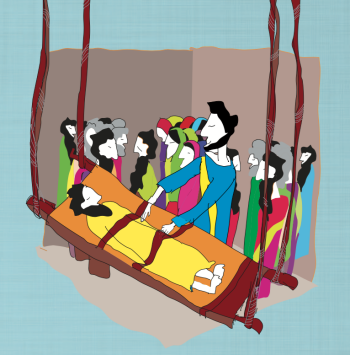
This week's lesson was 'Jesus Heals the Paralyzed Man' from story 90 of the Gospel Story Bible (Luke 5:17-26). Look over these teaching notes and use this week's Family Worship Guide to lead your family in devotions throughout this week.
Among a crowd of skeptics, men of faith were found—Consider who made up the crowd in this familiar story. Word spread throughout Israel about a new teacher who performed miracles and spoke with authority. As a result, on this day, religious leaders from across the country gathered to meet and listen to Jesus. By the time the men came with their paralyzed friend, the crowd had blocked their entry. Desperate to bring their crippled friend to Jesus, the men hoisted the stretcher up onto the roof and cut a hole to lower him through. The opening verse tells us that the power of the Lord was present for healing (Luke 5:17), but we do not read about any Pharisees being healed. They sat all around Jesus, and many of them had ailments Jesus could have cured. Yet the Pharisees had come to evaluate and judge Jesus, not to cry out to him. Doubt filled the hearts of the religious leaders, but the friends of the paralyzed man were filled with faith. Nothing would stop them from getting to Jesus.
Jesus knew their thoughts—Jesus knew the thoughts of everyone present. He knew the crippled man believed he could heal him, and he knew the religious rulers were doubters. So, instead of healing the man descending from the ceiling, Jesus called out and forgave his sins. The scribes and Pharisees were outraged, since they knew that only God could forgive sins. “Who gave this Jesus such authority,” they thought. But just as Jesus knew the faith of the crippled man, he also knew their thoughts. Today, we quickly forget that God is aware of every one of our thoughts. At times, we fool ourselves into thinking that our sins are somehow hidden from view. Our sins may be hidden from man (our friends, coworkers, parents), but our sins are never hidden from God. In spite of their unbelief, Jesus didn’t rebuke them; he gave them reason to believe and healed the paralyzed man. By restoring the man’s legs, Jesus demonstrated that he also possessed the authority to forgive sins.
The paralyzed man was healed and everyone was amazed—It is interesting to see the results of Jesus’ miracle. The man was no longer paralyzed and he left praising God, while everyone, including the Pharisees, gave praise to God as well. Though they were critical of Jesus, and didn’t fully see that Jesus was God, they knew that any healing was a work of God. Perhaps many religious rulers thought Jesus was a prophet, for the prophets of old could heal. Even so, prophets from the Old Testament did not personally forgive sins. In time, the Pharisees would become jealous of Jesus, feel threatened by his teaching, and label his claims blasphemous. Never did they realize that Jesus was more than a great teacher, a great prophet, and a great healer. Jesus was God.
 How does this story fit into God's bigger plan of redemption?
How does this story fit into God's bigger plan of redemption?
Jesus could forgive the sins of the crippled man because he knew what was before him. In a few short years, he would walk the road to Calvary and hang upon a tree. The crippled man’s sins would be placed upon Jesus, and the Father would pour out his anger for them and all the sins of mankind. Jesus would bear the punishment until God’s anger was completely exhausted, and then he would say, for the crippled man and for all the sins of all those who place their trust in Jesus, “It is finished” (John 19:30). People today have the same choice as those gathered in our story. We can either approach Jesus, critical of his teaching and skeptical of his claim to be God, or like the crippled man, we can demonstrate faith and allow nothing to come between us and seeing Jesus.


Comments
Login/Register to leave a comment